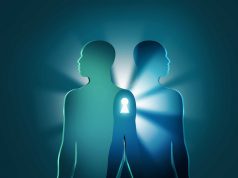Data from the first 5,000 UK Biobank participants taking part in the world’s largest health imaging study has been released for health researchers worldwide to use in their own research.
Meanwhile, early results from analysing brain imaging data alongside thousands of measures of lifestyle, physical fitness, cognitive health and physical measures such as body-mass-index (BMI) and bone density have been published in Nature Neuroscience.
The high quality of the imaging data and very large number of subjects allowed researchers to identify more than 30,000 significant associations between the many different brain imaging measures and the non-imaging measures. Results reported include:
- Strong associations between people’s cognitive processing speed and markers of the integrity of the brain’s “wiring” and the size of brain structures. These effects increased in strength as people aged.
- A negative correlation between brain activity during a simple shape-matching task and intelligence, an effect that didn’t relate to participants’ age. This might be because the people who scored more highly on the cognitive tests needed to use less of their brain to carry out the task.
- A pattern of strong associations between higher blood pressure, greater alcohol consumption, and several measures that could reflect injury to connections in the brain.
- A separate pattern of correlations, linking intake of alcohol and tobacco and changes in red blood cells and cardiac fitness, to brain imaging signals associated with increased iron deposits in the brain.
Researchers also unearthed some more complicated patterns of correlation. For example, one pattern links brain imaging to intelligence, level of education, and a set of lifestyle factors that at first appear unrelated – including amount of time spent outdoors and how much cheese people eat. It is plausible that, taken together, these factors create a profile of socio-economic-status and its relation to the brain.
However, because UK Biobank is an ‘observational’ study that characterises a cross-section of individuals, it’s not always straightforward to establish which factors cause which, but such results should help scientists to define much more precise questions to address in the future search for ways of preventing or treating brain disease.
Find your dream job in the space industry. Check our Space Job Board »
UK Biobank will be the world’s largest health imaging study. The imaging is funded by the Medical Research Council, Wellcome Trust, and the British Heart Foundation. It was launched in April 2016 after a number of years of planning and consultation with a large number of health and scanning experts. With the ambitious goal of imaging 100,000 existing UK Biobank participants, it is creating the biggest collection of scans of internal organs, to transform the way scientists study a wide range of diseases, including dementia, arthritis, cancer, heart attacks and stroke.
Today’s paper describes the brain imaging part of UK Biobank, led by Profs Steve Smith and Karla Miller (University of Oxford) and Paul Matthews (Imperial College London).
Professor Miller said: ‘We are using cutting-edge MRI scans and Big Data analysis methods to get the most comprehensive window into the brain that current imaging technology allows.
‘These results are just a first glimpse into this massive, rich dataset will that emerge in the coming years. It is an unparalleled resource that will transform our understanding of many common diseases.’
The paper reports first results from this remarkable data resource, which includes 6 different kinds of brain imaging done in the 30 minutes that each volunteer is in the brain scanner. ‘We have ‘structural imaging’ – that tells us about brain anatomy – the shapes and sizes of the different parts of the brain. Another kind – ‘functional MRI’ – tells us about complex patterns of brain activity. Yet another kind – ‘diffusion MRI’ – tells us about the brain’s wiring diagram. The rich and diverse information contained in these scans will reveal how the working of the brain can change with aging and disease; different diseases will best be understood through different combinations of information across these different images,’ explained Professor Smith.
UK Biobank has already scanned 10,000 participants, including images of the heart, body, bone and blood vessels in addition to brain scans. This will be by far the largest brain imaging study ever conducted; within another 5 years UK Biobank will have completed the scanning of 100,000 participants.
One reason for needing such large numbers of participants is to have enough subjects to allow discovery of early, possibly subtle, markers of future disease risk, both for a range of common diseases and for rare neurological disorders like motor neuron disease.
An important objective of the UK Biobank is to provide a resource for discovery of new insights into diseases like Alzheimer’s, which demands scanning healthy subjects years or decades before they develop symptoms. From the UK Biobank data, scientists anywhere can aim to learn much more about brain diseases – and their relationship to a broad range of other diseases or disease risks – to guide the development of earlier targeted treatment (or changes in lifestyle) that could in the future prevent major diseases from ever happening.
The paper, Multimodal population brain imaging in the UK Biobank prospective epidemiological study, is published online by Nature Neuroscience.
Source:University of Oxford
Research References:
- Karla L Miller, Fidel Alfaro-Almagro, Neal K Bangerter, David L Thomas, Essa Yacoub, Junqian Xu, Andreas J Bartsch, Saad Jbabdi, Stamatios N Sotiropoulos, Jesper L R Andersson, Ludovica Griffanti, Gwenaëlle Douaud, Thomas W Okell, Peter Weale, Iulius Dragonu, Steve Garratt, Sarah Hudson, Rory Collins, Mark Jenkinson, Paul M Matthews, Stephen M Smith. Multimodal population brain imaging in the UK Biobank prospective epidemiological study.Nature Neuroscience, 2016; DOI: 10.1038/nn.4393










